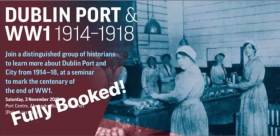Displaying items by tag: Centenary End of WW1
Centenary Seminar On the End of WW1: The Story of Dublin Port & City 1914-18 (Fully Booked) But More Events Planned!
#DublinPort - A seminar to mark the centenary of the end of WW1 is to be held in the Dublin Port Company's Port Centre building on Alexandra Road, tomorrow, Saturday, 3 November.
The event held in advance of the 100th anniversary of Armistice Day, is to involve talks from distinguished historians who will tell the story of Dublin Port and City from 1914-18.
TAKE NOTE: At this stage, please be advised the ticketed event is fully booked out!
For those of you who missed out this time, Dublin Port Company draws your attention to keep an eye on their Facebook page (click here) for more planned great historical seminars.
Background to Seminar on World War 1
From 1914 to 1923 the Irish people endured ten years of intense military activity, including participation in a World War, an urban insurrection, a Guerrilla War and finally a bitter Civil War.
The Result was a new nation bearing both the hopes of many of its citizens, and the pain left by the wars that had brought it into being. When Europe went to war in 1914, Ireland (as part of the British Empire) was automatically involved.
Over the course of the war, about 150,000 Irishmen volunteered to fight in the British Army and 30,000 were killed. The motives of the individual soldiers for enlisting varied and 59 members of the Dublin Port & Docks Board served in the Royal Navy and British Army, 4 of whom died.
At the same time the Dublin Dockyard Company opened a shell factory employing local women.
.
























































